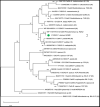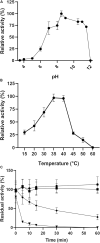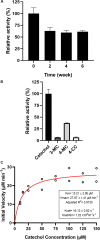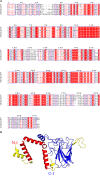Characterization of a Novel Functional Trimeric Catechol 1,2-Dioxygenase From a Pseudomonas stutzeri Isolated From the Gulf of Mexico
- PMID: 32582076
- PMCID: PMC7287156
- DOI: 10.3389/fmicb.2020.01100
Characterization of a Novel Functional Trimeric Catechol 1,2-Dioxygenase From a Pseudomonas stutzeri Isolated From the Gulf of Mexico
Abstract
Catechol 1,2 dioxygenases (C12DOs) have been studied for its ability to cleavage the benzene ring of catechol, the main intermediate in the degradation of aromatic compounds derived from aerobic degradation of hydrocarbons. Here we report the genome sequence of the marine bacterium Pseudomonas stutzeri GOM2, isolated from the southwestern Gulf of Mexico, and the biochemical characterization of its C12DO (PsC12DO). The catA gene, encoding PsC12DO of 312 amino acid residues, was cloned and expressed in Escherichia coli. Many C12DOs have been described as dimeric enzymes including those present in Pseudomonas species. The purified PsC12DO enzyme was found as an active trimer, with a molecular mass of 107 kDa. Increasing NaCl concentration in the enzyme reaction gradually reduced activity; in high salt concentrations (0.7 M NaCl) quaternary structural analysis determined that the enzyme changes to a dimeric arrangement and causes a 51% decrease in specific activity on catechol substrate. In comparison with other C12DOs, our enzyme showed a broad range of action for PsC12DO in solutions with pH values ranging from neutral to alkaline (70%). The enzyme is still active after incubation at 50°C for 30 min and in low temperatures to long term storage after 6 weeks at 4°C (61%). EDTA or Ca2+ inhibitors cause no drastic changes on residual activity; nevertheless, the activity of the enzyme was affected by metal ions Fe3+, Zn2+ and was completely inhibited by Hg2+. Under optimal conditions the k cat and K m values were 16.13 s-1 and 13.2 μM, respectively. To our knowledge, this is the first report describing the characterization of a marine C12DOs from P. stutzeri isolated from the Gulf of Mexico that is active in a trimeric state. We consider that our enzyme has important features to be used in environments in presence of EDTA, metals and salinity conditions.
Keywords: Pseudomonas; aromatic compounds; catechol degradation; intradiol dioxygenase; trimeric structure.
Copyright © 2020 Rodríguez-Salazar, Almeida-Juarez, Ornelas-Ocampo, Millán-López, Raga-Carbajal, Rodríguez-Mejía, Muriel-Millán, Godoy-Lozano, Rivera-Gómez, Rudiño-Piñera and Pardo-López.
Figures








Similar articles
-
Four Aromatic Intradiol Ring Cleavage Dioxygenases from Aspergillus niger.Appl Environ Microbiol. 2019 Nov 14;85(23):e01786-19. doi: 10.1128/AEM.01786-19. Print 2019 Dec 1. Appl Environ Microbiol. 2019. PMID: 31540981 Free PMC article.
-
Expression and cloning of catA encoding a catechol 1,2-dioxygenase from the 2,4-D-degrading strain Cupriavidus campinensis BJ71.Prep Biochem Biotechnol. 2020;50(5):486-493. doi: 10.1080/10826068.2019.1709978. Epub 2020 Jan 3. Prep Biochem Biotechnol. 2020. PMID: 31900038
-
Bacterial aromatic ring-cleavage enzymes are classified into two different gene families.J Biol Chem. 1989 Sep 15;264(26):15328-33. J Biol Chem. 1989. PMID: 2670937
-
Cloning, DNA sequencing, and amino acid sequencing of catechol 1,2-dioxygenases (pyrocatechase) from Pseudomonas putida mt-2 and Pseudomonas arvilla C-1.Arch Biochem Biophys. 1995 Aug 20;321(2):353-62. doi: 10.1006/abbi.1995.1405. Arch Biochem Biophys. 1995. PMID: 7646060
-
Versatile catechol dioxygenases in Sphingobium scionense WP01T.Antonie Van Leeuwenhoek. 2018 Dec;111(12):2293-2301. doi: 10.1007/s10482-018-1120-y. Epub 2018 Jun 29. Antonie Van Leeuwenhoek. 2018. PMID: 29959655
Cited by
-
Draft genome sequence of Pseudomonas sp. GOM6, a lipolytic strain isolated from seawater of the Gulf of Mexico.Microbiol Resour Announc. 2023 Sep 19;12(9):e0034823. doi: 10.1128/MRA.00348-23. Epub 2023 Jul 20. Microbiol Resour Announc. 2023. PMID: 37470493 Free PMC article.
-
Pseudomonas in environmental bioremediation of hydrocarbons and phenolic compounds- key catabolic degradation enzymes and new analytical platforms for comprehensive investigation.World J Microbiol Biotechnol. 2022 Jul 21;38(10):165. doi: 10.1007/s11274-022-03349-7. World J Microbiol Biotechnol. 2022. PMID: 35861883 Review.
-
A Novel Thermo-Alkaline Stable GDSL/SGNH Esterase with Broad Substrate Specificity from a Deep-Sea Pseudomonas sp.Mar Biotechnol (NY). 2024 Jun;26(3):447-459. doi: 10.1007/s10126-024-10308-w. Epub 2024 May 1. Mar Biotechnol (NY). 2024. PMID: 38691271 Free PMC article.
-
Cleaner horizons: Exploring advanced technologies for pollution remediation.Biotechnol Rep (Amst). 2025 Mar 28;46:e00890. doi: 10.1016/j.btre.2025.e00890. eCollection 2025 Jun. Biotechnol Rep (Amst). 2025. PMID: 40255475 Free PMC article. Review.
-
Investigating the quaternary structure of a homomultimeric catechol 1,2-dioxygenase: An integrative structural biology study.PLoS One. 2025 May 5;20(5):e0315992. doi: 10.1371/journal.pone.0315992. eCollection 2025. PLoS One. 2025. PMID: 40323932 Free PMC article.
References
-
- Al-Hakim M. H., Hasan R., Ali M. H., Rabbee M. F., Marufatuzzahan H. M., Joy Z. F. (2015). In-silico characterization and homology modeling of catechol 1,2 dioxygenase involved in processing of catechol- an intermediate of aromatic compound degradation pathway. Glob. J. Sci. Front. Res. G Bio-Tech Genet. 15 1–13.
-
- Bagdasarian M., Lurz R., Ruckert B., Franklin F. C., Bagdasarian M. M., Frey J., et al. (1981). Specific-purpose plasmid cloning vectors. II. Broad host range, high copy number, RSF1010-derived vectors, and a host-vector system for gene cloning in Pseudomonas. Gene 16 237–247. 10.1016/0378-1119(81)90080-9 - DOI - PubMed
LinkOut - more resources
Full Text Sources
Molecular Biology Databases
Miscellaneous

